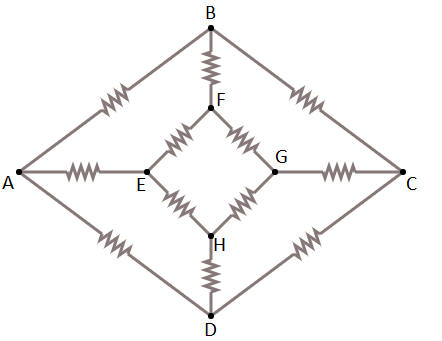
In the network shown in figure each resistance is $R$. The equivalent resistance between $A\& B$ is:

A) $\dfrac{{3R}}{4}$
B) $\dfrac{{5R}}{6}$
C) $\dfrac{{7R}}{{12}}$
D) $\dfrac{{4R}}{{13}}$
Answer
219.3k+ views
Hint: 1. Resistors are said to be connected in parallel if the current flow each resistor is different.
2. If two resistance or impedances are connected in parallel are equal and of the same value. The total or equivalent resistance ${R_T}$ is equal to the half the value of one resistor. That is equal to $\dfrac{R}{2}$ for two resistor in parallel and for three equal resistors connected in parallel is $\dfrac{R}{3}$ and four it is $\dfrac{R}{4}$.
3. Treated current as water in case of solving the resistances problems. If the current or water flows by the same amount then the connection is in series.
If the $\dfrac{{Current}}{{Water}}$ is distributed or divided among the parts then it is in parallel.
Complete step by step solution:
The given figure is

Step 1: Here if we connected the battery between $A{{ \& C}}$ , then there is no current flow between the resistances between $B{{ \& F}}$ and between the $H{{ \& D}}$ . It is because the current is treated as a balanced wheatstone bridge.
So they can be removed and the corresponding equivalent figure here we have is.

On simplifying the above figure,

Now further the above figure can be solved as,

Furthur the above figure can be simplified as shown in the below figure,

In the above figure all three resistances in parallel.
Now in according the above figure $\left( {1.02} \right)$
The equivalent resistance between $E{{ \& G}}$ is
${R_{EG}} = \dfrac{{\left( {R + R} \right)\left( {R + R} \right)}}{{\left( {R + R} \right) + \left( {R + R} \right)}} = \dfrac{{\left( {2R} \right)\left( {2R} \right)}}{{\left( {2R} \right) + \left( {2R} \right)}}$
Now here we have
${R_{EG}} = \dfrac{{4{R^2}}}{{4R}} = R$
${R_{EG}} = R$
Now net resistance is
${R_{AC}} = \dfrac{{3R}}{4}$
Therefore, option (A) is correct.
Note:
Principle of wheatstone bridge: The wheatstone bridge principle states that if for resistance $P,Q,R\,{{\& S}}$ are arranged to form a bridge with a cell and key between $A$ and $C$ and a galvanometer between $B$ and $D$ the bridge is said to be balanced when the galvanometer shows no deflection.

The arrangement of a wheatstone bridge is as shown in the figure $\left( {2.01} \right)$
As if a wheatstone bridge is said to be balanced then
$\dfrac{P}{Q} = \dfrac{R}{S}$
In case when the galvanometer shows no deflection.
2. If two resistance or impedances are connected in parallel are equal and of the same value. The total or equivalent resistance ${R_T}$ is equal to the half the value of one resistor. That is equal to $\dfrac{R}{2}$ for two resistor in parallel and for three equal resistors connected in parallel is $\dfrac{R}{3}$ and four it is $\dfrac{R}{4}$.
3. Treated current as water in case of solving the resistances problems. If the current or water flows by the same amount then the connection is in series.
If the $\dfrac{{Current}}{{Water}}$ is distributed or divided among the parts then it is in parallel.
Complete step by step solution:
The given figure is

Step 1: Here if we connected the battery between $A{{ \& C}}$ , then there is no current flow between the resistances between $B{{ \& F}}$ and between the $H{{ \& D}}$ . It is because the current is treated as a balanced wheatstone bridge.
So they can be removed and the corresponding equivalent figure here we have is.

On simplifying the above figure,

Now further the above figure can be solved as,

Furthur the above figure can be simplified as shown in the below figure,

In the above figure all three resistances in parallel.
Now in according the above figure $\left( {1.02} \right)$
The equivalent resistance between $E{{ \& G}}$ is
${R_{EG}} = \dfrac{{\left( {R + R} \right)\left( {R + R} \right)}}{{\left( {R + R} \right) + \left( {R + R} \right)}} = \dfrac{{\left( {2R} \right)\left( {2R} \right)}}{{\left( {2R} \right) + \left( {2R} \right)}}$
Now here we have
${R_{EG}} = \dfrac{{4{R^2}}}{{4R}} = R$
${R_{EG}} = R$
Now net resistance is
${R_{AC}} = \dfrac{{3R}}{4}$
Therefore, option (A) is correct.
Note:
Principle of wheatstone bridge: The wheatstone bridge principle states that if for resistance $P,Q,R\,{{\& S}}$ are arranged to form a bridge with a cell and key between $A$ and $C$ and a galvanometer between $B$ and $D$ the bridge is said to be balanced when the galvanometer shows no deflection.

The arrangement of a wheatstone bridge is as shown in the figure $\left( {2.01} \right)$
As if a wheatstone bridge is said to be balanced then
$\dfrac{P}{Q} = \dfrac{R}{S}$
In case when the galvanometer shows no deflection.
Recently Updated Pages
Conformers of Alkanes Important Concepts and Tips for JEE

JEE Main 2023 (February 1st Shift 2) Maths Question Paper with Answer Key

JEE Main 2023 (January 30th Shift 1) Maths Question Paper with Answer Key

Equivalent Capacitance Explained: Formulas, Series & Parallel

Household Electricity: Basics, Usage & Safety Explained

JEE Main 2022 (January 31st Shift 2) Chemistry Question Paper with Answer Key

Trending doubts
JEE Main 2026: Application Form Open, Exam Dates, Syllabus, Eligibility & Question Papers

Understanding Uniform Acceleration in Physics

Derivation of Equation of Trajectory Explained for Students

Hybridisation in Chemistry – Concept, Types & Applications

Understanding the Angle of Deviation in a Prism

Understanding Collisions: Types and Examples for Students

Other Pages
JEE Advanced Marks vs Ranks 2025: Understanding Category-wise Qualifying Marks and Previous Year Cut-offs

Understanding Atomic Structure for Beginners

How to Convert a Galvanometer into an Ammeter or Voltmeter

Understanding Centrifugal Force in Physics

JEE Main Marking Scheme 2026- Paper-Wise Marks Distribution and Negative Marking Details

Degree of Dissociation: Meaning, Formula, Calculation & Uses




